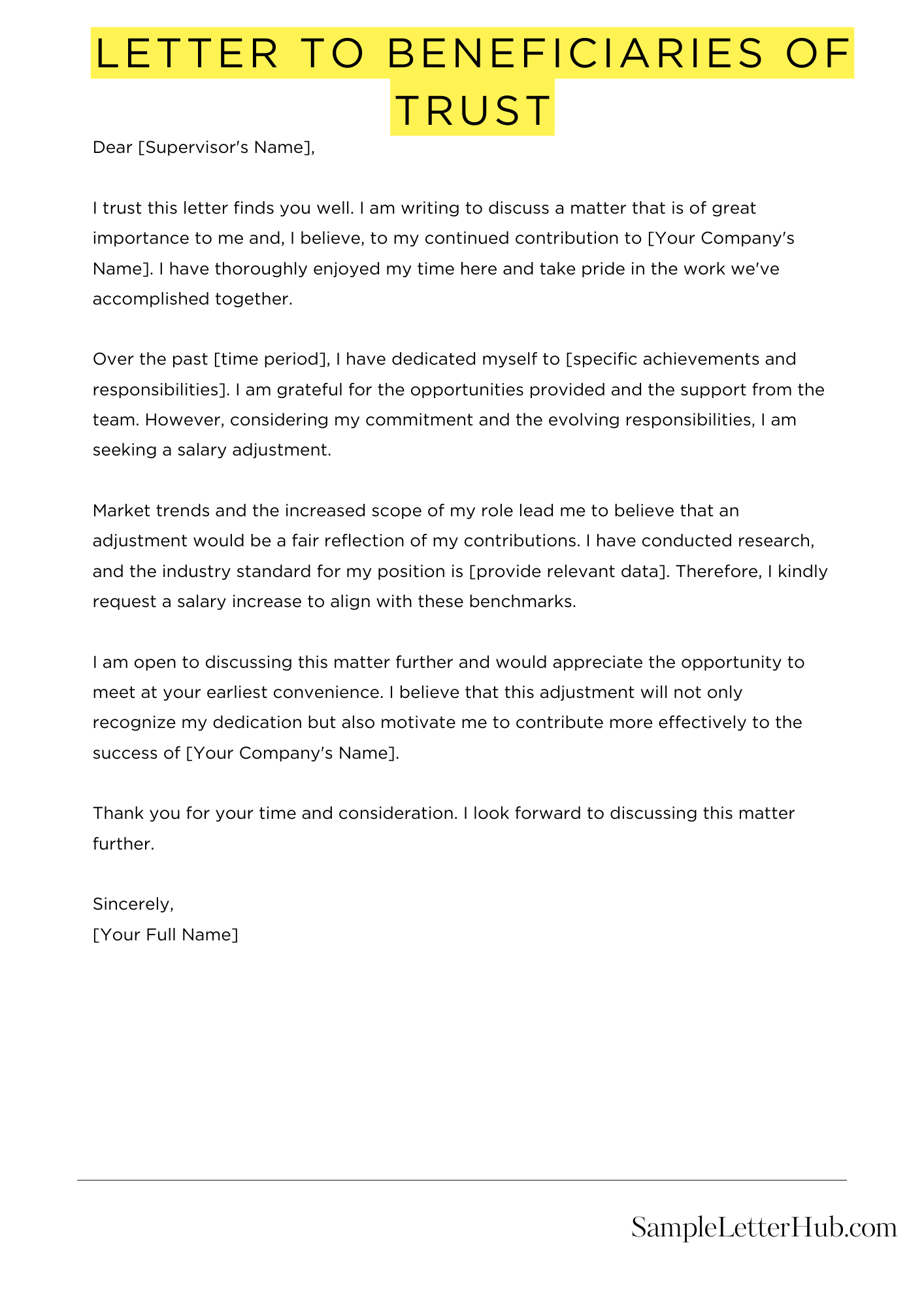A Letter To Beneficiaries Of Trust is a document that informs the beneficiaries of a trust about their rights and responsibilities. It typically includes information about the trust’s assets, the distribution of those assets, and the terms of the trust.
In this article, we will share templates, examples, and samples of Letter To Beneficiaries Of Trust. These letters can be used as a starting point for drafting your own letter.
Letter to Beneficiaries of Trust
Dear Beneficiaries,
I am writing to you today to inform you that you have been named as beneficiaries of a trust that was established by [Name of Grantor]. The trust was created on [Date of Creation] and is irrevocable.
The purpose of the trust is to [State the Purpose of the Trust]. The trust assets consist of [List of Assets].
You are entitled to receive distributions from the trust in accordance with the terms of the trust document. The trustee has the discretion to make distributions to you for your health, education, maintenance, and support.
The trustee is [Name of Trustee]. The trustee’s contact information is [Contact Information].
If you have any questions about the trust, please do not hesitate to contact the trustee.
Sincerely,
[Your Name]

How to Write Letter To Beneficiaries Of Trust
Writing a letter to beneficiaries of a trust can be a daunting task, but it is important to do it correctly to ensure that the beneficiaries understand their rights and responsibilities.
1. Start with a Formal Salutation
Begin your letter with a formal salutation, such as “Dear Beneficiaries” or “To Whom It May Concern.”
2. Identify Yourself and Your Role
Clearly state your name and your role in relation to the trust, such as “I am the trustee of the John Doe Trust” or “I am the attorney for the beneficiaries of the John Doe Trust.”
3. Explain the Purpose of the Letter
Briefly explain the purpose of the letter, such as to provide information about the trust, to distribute assets, or to request information from the beneficiaries.
4. Provide Details about the Trust
Provide relevant details about the trust, such as the name of the trust, the date it was created, and the settlor (the person who created the trust).
5. Outline the Beneficiaries’ Rights and Responsibilities
Clearly outline the beneficiaries’ rights and responsibilities under the trust, such as their right to receive distributions, their obligation to pay taxes, and their right to contest the trust.
6. Provide Contact Information
Provide your contact information so that the beneficiaries can reach you if they have any questions or concerns.
7. Close with a Formal Valediction
End your letter with a formal valediction, such as “Sincerely” or “Respectfully.”
FAQs about Letter To Beneficiaries Of Trust
What is a letter to beneficiaries of a trust?
A letter to beneficiaries of a trust is a document that is sent to the beneficiaries of a trust by the trustee. The letter typically provides information about the trust, including the terms of the trust, the assets of the trust, and the distribution of the trust assets to the beneficiaries.
Who should receive a letter to beneficiaries of a trust?
A letter to beneficiaries of a trust should be sent to all of the beneficiaries of the trust. This includes both current beneficiaries and future beneficiaries.
What should be included in a letter to beneficiaries of a trust?
A letter to beneficiaries of a trust should include the following information:
- The name of the trust
- The date of the trust
- The name of the trustee
- The terms of the trust
- The assets of the trust
- The distribution of the trust assets to the beneficiaries
When should a letter to beneficiaries of a trust be sent?
A letter to beneficiaries of a trust should be sent as soon as possible after the trust is created. This will give the beneficiaries time to review the terms of the trust and to ask any questions that they may have.
What are the benefits of sending a letter to beneficiaries of a trust?
There are several benefits to sending a letter to beneficiaries of a trust. These benefits include:
- It provides the beneficiaries with information about the trust.
- It helps to avoid misunderstandings about the terms of the trust.
- It can help to build a relationship between the trustee and the beneficiaries.

